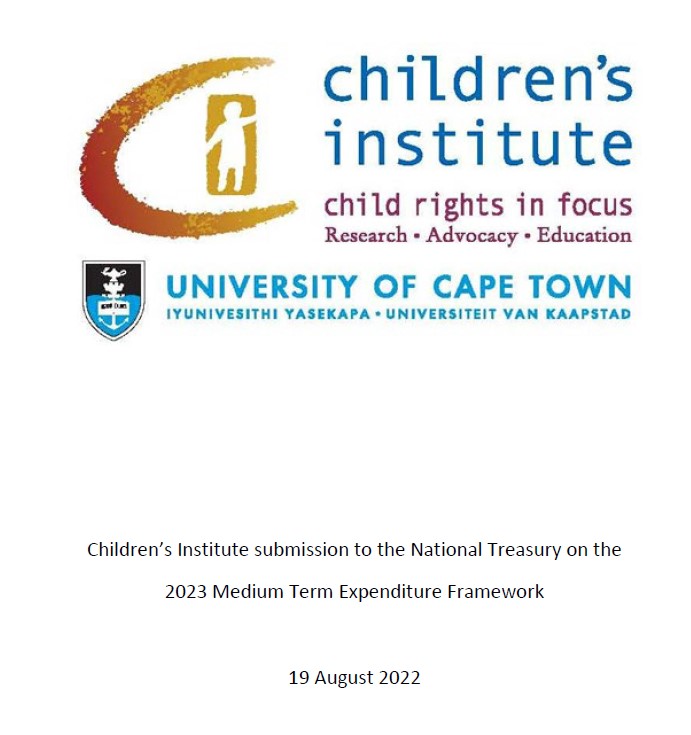 Child abuse & protection
Child abuse & protection
Neglect
Date: March 2018Definition
The 2016 Optimus study used five scenarios to measure child physical neglect, as shown below. Adolescents aged 15 to 17 years who reported experiencing any one (or more) of these situations are regarded as having been subject to neglect in their lifetimes. Overall, 12% of adolescents in the household survey reported experiencing at least one of these forms of neglect at some point. Data

Notes
Participants in this study were adolescents aged 15 to 17 years old.
Source
Artz L, Burton P, Ward C et al (2016) Optimus Study South Africa: Technical Report. Sexual Victimisation of Children in South Africa. Final Report of the Optimus Foundation Study: South Africa. Zurich: UBS Optimus Foundation (p88). Weighted household data, interviewer administered questionnaire.
What do the numbers tell us?
The Children’s Act (2005) defines neglect as “a failure in the exercise of parental responsibilities to provide for the basic physical, intellectual, emotional or social needs” of the child.
The United National Committee on the Rights of the Child (2011) provides a slightly more detailed definition, noting that neglect involves the "failure to meet children’s physical and psychological needs, protect them from danger, or obtain medical, birth registration or other services when those responsible for children’s care have the means, knowledge and access to services to do so" .
Neglect is distinguished from circumstances of poverty in that neglect occurs only in cases where reasonable resources are available to the family or caregiver; that is, where a parent or caregiver is in a position to meet a child's need but fails to do so.
The forms of neglect described in the 2016 Optimus study are all types of physical neglect. The proportion of adolescents (12%) reporting experiences of neglect in the study appears low, but few studies have been conducted on child neglect in low and middle-income countries and so there is little against which to compare these findings.
Child neglect is an area that has received less attention than other forms of violence, in part because of the difficulties involved in defining and measuring neglect across cultures and different socio-economic contexts. It is generally recognised that a key aspect of neglect is not simply the failure to meet the needs of a child, but that this failure occurs despite the parent or caregiver being in a position to meet these needs. In this way, parents living in poverty who are unable to provide for their children because of financial or other constraints are not defined as neglectful.
However, this can be difficult to differentiate in practice, which in turn impacts on estimates of prevalence. For example, a recent study on child abuse victimisation in South Africa using a multi-community sample did not include childhood neglect "due to high poverty within the sample, which made distinction between neglectful behaviour and poverty-related inability to provide diffcult".1
___________________________________________________________________________________________________________
1 Meinck F, Cluver L, Boyes M & Loening-Voysey H (2016) Physical, emotional and sexual adolescent abuse victimisation in South Africa: prevalence, incidence, perpetrators and locations. J Epidemiol Community Health, 70:910-916.
The United National Committee on the Rights of the Child (2011) provides a slightly more detailed definition, noting that neglect involves the "failure to meet children’s physical and psychological needs, protect them from danger, or obtain medical, birth registration or other services when those responsible for children’s care have the means, knowledge and access to services to do so" .
Neglect is distinguished from circumstances of poverty in that neglect occurs only in cases where reasonable resources are available to the family or caregiver; that is, where a parent or caregiver is in a position to meet a child's need but fails to do so.
The forms of neglect described in the 2016 Optimus study are all types of physical neglect. The proportion of adolescents (12%) reporting experiences of neglect in the study appears low, but few studies have been conducted on child neglect in low and middle-income countries and so there is little against which to compare these findings.
Child neglect is an area that has received less attention than other forms of violence, in part because of the difficulties involved in defining and measuring neglect across cultures and different socio-economic contexts. It is generally recognised that a key aspect of neglect is not simply the failure to meet the needs of a child, but that this failure occurs despite the parent or caregiver being in a position to meet these needs. In this way, parents living in poverty who are unable to provide for their children because of financial or other constraints are not defined as neglectful.
However, this can be difficult to differentiate in practice, which in turn impacts on estimates of prevalence. For example, a recent study on child abuse victimisation in South Africa using a multi-community sample did not include childhood neglect "due to high poverty within the sample, which made distinction between neglectful behaviour and poverty-related inability to provide diffcult".1
___________________________________________________________________________________________________________
1 Meinck F, Cluver L, Boyes M & Loening-Voysey H (2016) Physical, emotional and sexual adolescent abuse victimisation in South Africa: prevalence, incidence, perpetrators and locations. J Epidemiol Community Health, 70:910-916.
Technical notes
The 2016 national prevalence survey on child sexual victimisation consisted of a population-based survey and an accompanying school-based survey. The household survey was based on a multi-stage stratified sample designed to produce a nationally representative sample and which used province, geographic area (urban/rural) and race group as stratification variables (see the technical study report for more detail). The schools were clustered according to the Enumerator Areas (EAs) identified in the household survey; as a result the data is not representative of the school population.
One adolescent aged 15 – 17 years was interviewed per selected household. Active informed consent was obtained from parents and informed assent was obtained from the adolescent. In the school-based survey, a total of 30 interviews were completed (10 learners each from grades 10 to 12) per school. Passive parental consent was sought at schools. The household sample consisted of 5 631 participants (refusal rate: 5.2%), while the school-based survey comprised 4 086 learners (refusal rate: 3.9%).
In reporting the findings, we have drawn on the nationally representative household survey data. Where possible, we report the findings from the self-administered component as we consider them to be more reliable given the anonymity involved. There does appear to have been a greater willingness to disclose in the self-administered component, with rates reported in this component generally being higher than those reported in the interviewer-administered component.
One adolescent aged 15 – 17 years was interviewed per selected household. Active informed consent was obtained from parents and informed assent was obtained from the adolescent. In the school-based survey, a total of 30 interviews were completed (10 learners each from grades 10 to 12) per school. Passive parental consent was sought at schools. The household sample consisted of 5 631 participants (refusal rate: 5.2%), while the school-based survey comprised 4 086 learners (refusal rate: 3.9%).
In reporting the findings, we have drawn on the nationally representative household survey data. Where possible, we report the findings from the self-administered component as we consider them to be more reliable given the anonymity involved. There does appear to have been a greater willingness to disclose in the self-administered component, with rates reported in this component generally being higher than those reported in the interviewer-administered component.
Strengths and limitations of the data
A strength of the prevalence survey is that it captures incidents that are not reported to the authorities and therefore do not appear in administrative data. The Optimus survey also drew on different sites (home and school) and different methods of collecting the data (interviewer and self-administered questionnaires), and shows how the approach taken can influence the levels of reporting.
A potential limitation was the ethical requirement of obtaining parental consent in the household survey. Consent and informed assent is essential to research ethics, but there is a concern that parents who may themselves be abusers may have refused to consent and therefore biased the results.
A further limitation is that the data cannot be disaggregated beyond provincial level, and in most cases the small numbers reporting various forms of abuse makes disaggregation even to this level difficult. Obtaining data at a lower level (e.g. district) is important for understanding where violence against children is most prevalent, and which groups of children are most at risk.
Lastly, this survey fills an important data gaps in understanding the prevalence of sexual violence against children (in the context of other forms of violence), but it is not a regular survey and so does not provide surveillance data that can be used to monitor trends over time.
A potential limitation was the ethical requirement of obtaining parental consent in the household survey. Consent and informed assent is essential to research ethics, but there is a concern that parents who may themselves be abusers may have refused to consent and therefore biased the results.
A further limitation is that the data cannot be disaggregated beyond provincial level, and in most cases the small numbers reporting various forms of abuse makes disaggregation even to this level difficult. Obtaining data at a lower level (e.g. district) is important for understanding where violence against children is most prevalent, and which groups of children are most at risk.
Lastly, this survey fills an important data gaps in understanding the prevalence of sexual violence against children (in the context of other forms of violence), but it is not a regular survey and so does not provide surveillance data that can be used to monitor trends over time.






 The SAECR 2024 tracks trends on the status of children under 6.
The SAECR 2024 tracks trends on the status of children under 6. 








